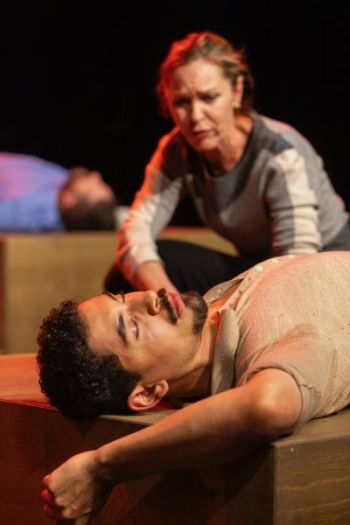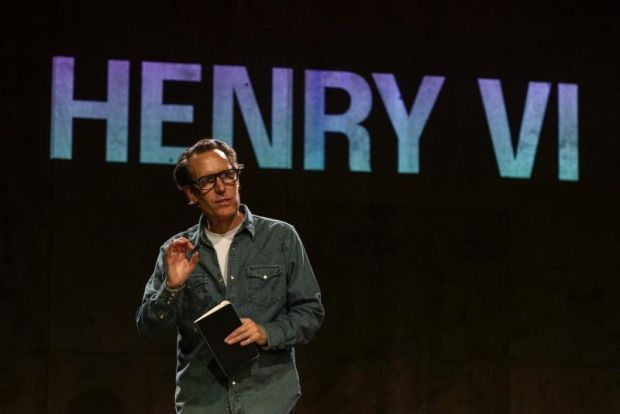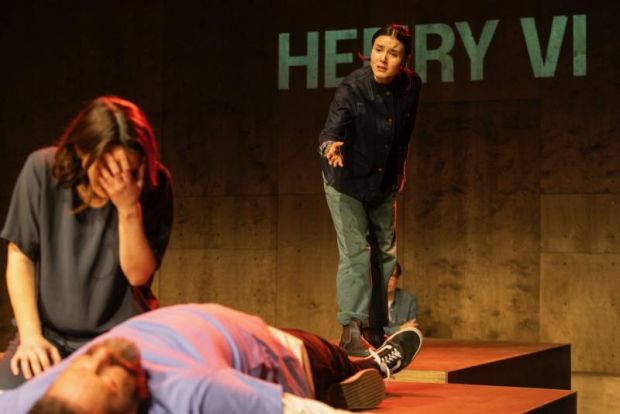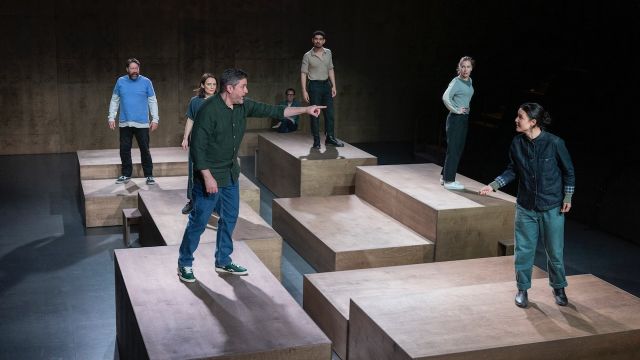In a Nutshell: The Poetry of Violence
I have a confession: in spite of 15 years of reviewing, I still find Shakespeare’s language difficult. The vocabulary and metaphor is so dense that I get lost, and I try to plough through Spark Notes in advance. That way I hopefully don’t get caught out by, say, why Cleopatra and Antony were so anxious about a family of swans. The swans are metaphorical ships. I’m sure you all know this. I did not. In fact, I got through high school being able to quote Hamlet’s famous soliloquy without ever realising he was referencing suicide. Add to this my vague resentment at the historical elitism of the appreciation of The Bard and you get the backpack of confusion I haul with me to any Shakespeare production.
 For this reason I value Peter Evans’ work as John Bell’s successor. Evans is cogniscent that the vast majority of the audience is as likely as I am to be dog-paddling in a sea of Elizabethan scansion. His productions seem to attempt to meet a modern audience where they are with a proverbial life-raft. This can involve quite extreme editing, like in the 2018 production of Anthony and Cleopatra, where he ran two scenes concurrently with rapid-fire cinematic cuts to contrast the differing vibes and built tension. Or it can use references to popular culture, memorably and somewhat less successfully in the 2012 production of Macbeth which perplexed audiences by giving the witches a Peter Jacksoneque ring-tempted evil Galadriel overlaid voice effect, and presenting Banquo as the zombie dinner guest from Hell.
For this reason I value Peter Evans’ work as John Bell’s successor. Evans is cogniscent that the vast majority of the audience is as likely as I am to be dog-paddling in a sea of Elizabethan scansion. His productions seem to attempt to meet a modern audience where they are with a proverbial life-raft. This can involve quite extreme editing, like in the 2018 production of Anthony and Cleopatra, where he ran two scenes concurrently with rapid-fire cinematic cuts to contrast the differing vibes and built tension. Or it can use references to popular culture, memorably and somewhat less successfully in the 2012 production of Macbeth which perplexed audiences by giving the witches a Peter Jacksoneque ring-tempted evil Galadriel overlaid voice effect, and presenting Banquo as the zombie dinner guest from Hell.
Which brings us to the Nutshell series which aims to show how Shakespeare used various literary, theatrical and poetic devices throughout his plays. The Poetry of Violence is essentially the primer I wish I’d had back in high school. Presenting scenes from plays in roughly chronological order, Evans illustrates how Shakespeare’s skill with metaphor developed from simple simile in 3 Henry VI to the rich symbolism of Macbeth, plays the post-murder scene from Julius Caesar twice to show how different emphases can make Caesar’s killers either somber but triumphant, or struck with the horror of their actions. We saw how Shakespeare’s characters gained nuance and complexity, and got an appreciation for the poetic power of how he juxtaposed exquisitely beautiful imagery with bloody barbarism.

Evans considers three time contexts for each production, namely the era the play was set, the date it was written, and the modern era. What does a lay audience in 2024 need in order to understand each play? What will they not accept? With this in mind, Bell’s fight director Nigel Poulton demonstrated how two different schools of swordsmanship extant in Shakespeare’s time (but not in medieval Verona) informed the duel between Mercutio and Tybalt in Romeo and Juliet.
By illustrating his points through live scenes made this far more engaging approach than a dry lecture. It helps that the actors are sufficiently strong to snap the audience into the world of each play with each fragment with a generic set and costuming. Each of the cast holds their own, but it was a particular joy to watch Lucy Bell get to the guts of the livid and vengeful Queen Margaret in 3 Henry VI, and how she played Lady Macbeth hollowed with barely-acknowledged guilt. Also memorably, Jessica Tovey and Darius Williams imbued the unfortunate Lady MacDuff and her son with a finely calibrated combination of anger, dread and gallows humour.

On occasion I’ve overheard theatre goers say they have gone off Bell Shakespeare since Peter Evans took over (although it is possible that that 2012 Macbeth put them off, in which case I’d suggest they try again). Possibly the In a Nutshell series isn’t for aficionados. But if, like me, you relish the opportunity to have Shakespeare demystified, you’ll enjoy it as well. I’m looking forward to the next installment.
Cathy Bannister
Photographer: Brett Boardman
Subscribe to our E-Newsletter, buy our latest print edition or find a Performing Arts book at Book Nook.

